02 requests接口测试-requests的安装
安装常见问题
- 提示连接不上,443问题
一般是因为浏览器设置了代理,关闭代理。
- 网络加载慢,设置国内镜像地址
1.pip安装
2.pycharm安装
- 国内镜像源
清华:https://pypi.tuna.tsinghua.edu.cn/simple
阿里云:http://mirrors.aliyun.com/pypi/simple/
中国科技大学 https://pypi.mirrors.ustc.edu.cn/simple/
华中理工大学:http://pypi.hustunique.com/
山东理工大学:http://pypi.sdutlinux.org/
豆瓣:http://pypi.douban.com/simple/
- 临时使用
在使用pip的时候加参数-i https://pypi.tuna.tsinghua.edu.cn/simple
例如:pip install -i https://pypi.tuna.tsinghua.edu.cn/simple pyspider,这样就会从清华镜像去安装pyspider库。
03 requests接口测试-requests原理与代码解析
- requests工作原理
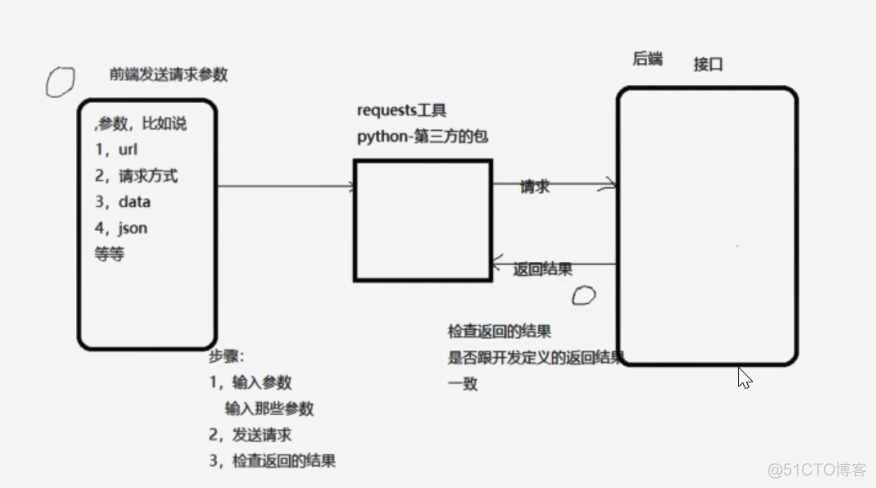
- 代码解析
通过追踪代码,可以发现requests实际上是调用了request方法,源码如下:
method, url是必填参数,其他是可选参数。
参数method,有GET, OPTIONS, HEAD, POST, PUT, PATCH, DELETE。
可选参数可以发送data、json、headers、cookies、flies、auth、timeout、proxies、verify、stream、cert
def request(method, url, **kwargs):"""Constructs and sends a :class:`Request <Request>`.
:param method: method for the new :class:`Request` object: ``GET``, ``OPTIONS``, ``HEAD``, ``POST``, ``PUT``, ``PATCH``, or ``DELETE``.
:param url: URL for the new :class:`Request` object.
:param params: (optional) Dictionary, list of tuples or bytes to send
in the query string for the :class:`Request`.
:param data: (optional) Dictionary, list of tuples, bytes, or file-like
object to send in the body of the :class:`Request`.
:param json: (optional) A JSON serializable Python object to send in the body of the :class:`Request`.
:param headers: (optional) Dictionary of HTTP Headers to send with the :class:`Request`.
:param cookies: (optional) Dict or CookieJar object to send with the :class:`Request`.
:param files: (optional) Dictionary of ``'name': file-like-objects`` (or ``{'name': file-tuple}``) for multipart encoding upload.
``file-tuple`` can be a 2-tuple ``('filename', fileobj)``, 3-tuple ``('filename', fileobj, 'content_type')``
or a 4-tuple ``('filename', fileobj, 'content_type', custom_headers)``, where ``'content-type'`` is a string
defining the content type of the given file and ``custom_headers`` a dict-like object containing additional headers
to add for the file.
:param auth: (optional) Auth tuple to enable Basic/Digest/Custom HTTP Auth.
:param timeout: (optional) How many seconds to wait for the server to send data
before giving up, as a float, or a :ref:`(connect timeout, read
timeout) <timeouts>` tuple.
:type timeout: float or tuple
:param allow_redirects: (optional) Boolean. Enable/disable GET/OPTIONS/POST/PUT/PATCH/DELETE/HEAD redirection. Defaults to ``True``.
:type allow_redirects: bool
:param proxies: (optional) Dictionary mapping protocol to the URL of the proxy.
:param verify: (optional) Either a boolean, in which case it controls whether we verify
the server's TLS certificate, or a string, in which case it must be a path
to a CA bundle to use. Defaults to ``True``.
:param stream: (optional) if ``False``, the response content will be immediately downloaded.
:param cert: (optional) if String, path to ssl client cert file (.pem). If Tuple, ('cert', 'key') pair.
:return: :class:`Response <Response>` object
:rtype: requests.Response
Usage::
>>> import requests
>>> req = requests.request('GET', 'https://httpbin.org/get')
>>> req
<Response [200]>
"""
# By using the 'with' statement we are sure the session is closed, thus we
# avoid leaving sockets open which can trigger a ResourceWarning in some
# cases, and look like a memory leak in others.
with sessions.Session() as session:
return session.request(method=method, url=url, **kwargs)
04 requests接口测试-get请求
- 请求参数保存在url中,?后面添加参数名称和参数值,如果有多个参数,使用&连接
- 请求参数保存在params中,params以字典形式保存数据
接口说明:
淘宝网
API地址: http://tcc.taobao.com/cc/json/mobile_tel_segment.htm?tel=13909161860
参数:
tel:手机号码
返回:JSON
import requestsdef test_get():
# 参数保存在url中,?后面添加参数名称和参数值,如果有多个参数,使用&连接
url = 'http://tcc.taobao.com/cc/json/mobile_tel_segment.htm?tel=13909161860'
r=requests.get(url=url)
print(r.text)
print(r.status_code)
print(r.cookies)
print(r.url)
# 参数保存在params中,params以字典形式保存数据
url = 'http://tcc.taobao.com/cc/json/mobile_tel_segment.htm'
params={'tel':13909161860}
r=requests.get(url=url,params=params)
print(r.text)
print(r.status_code)
print(r.cookies)
print(r.url)
获取响应结果
import requestsdef test_requests():
r = requests.get('https://www.baidu.com')
print('\n')
print('状态码是:', r.status_code)
print('url是:', r.url)
print('头信息是:', r.headers)
print('cookies是:', r.cookies)
print('text是:', r.text)
print('请求是:', r.request)
05 requests接口测试-post请求
- post发送form格式请求参数,使用data
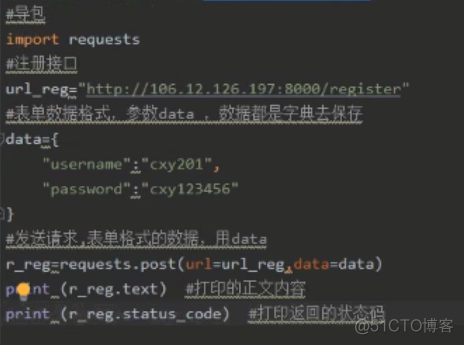
- post发送json格式请求参数,使用json
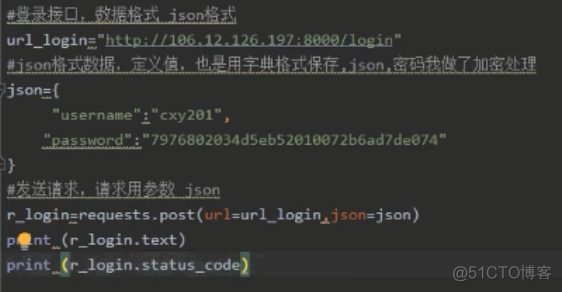
06 requests接口测试-cookies值
- 什么是cookies?
相当于临时身份证。
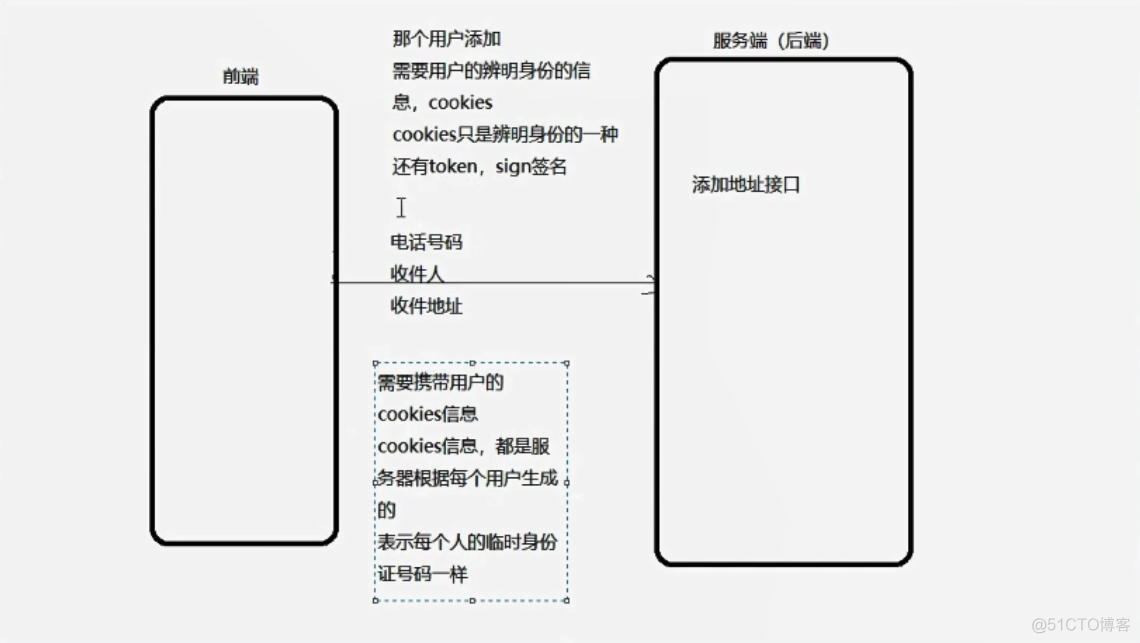

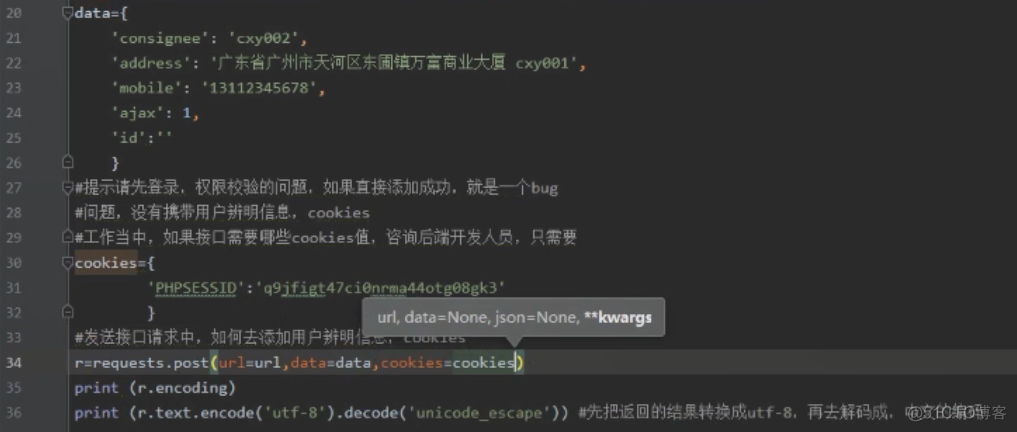
- 谷歌浏览器抓包
查看请求参数的格式,看Content-Type字段
如:Content-Type: text/html;charset=utf8,表示请求参数是text格式,编码是utf-8

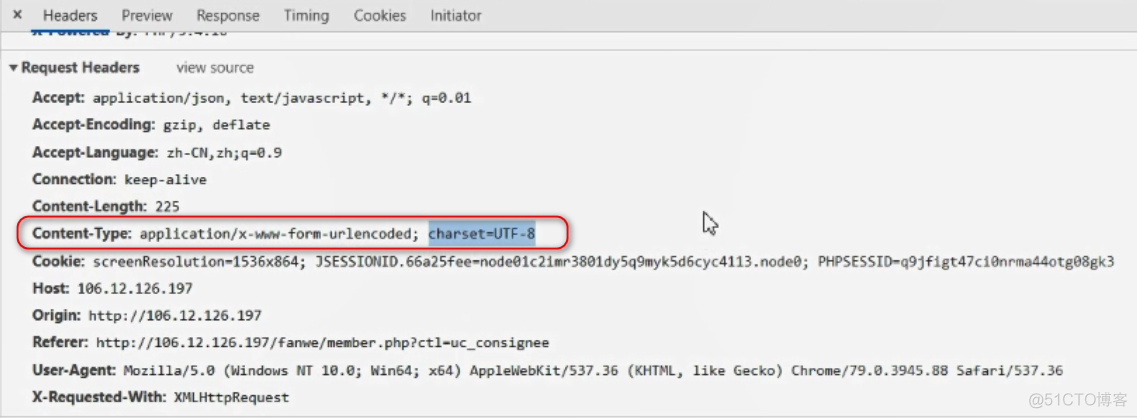
如果是form式,可以查看form data具体发送的参数
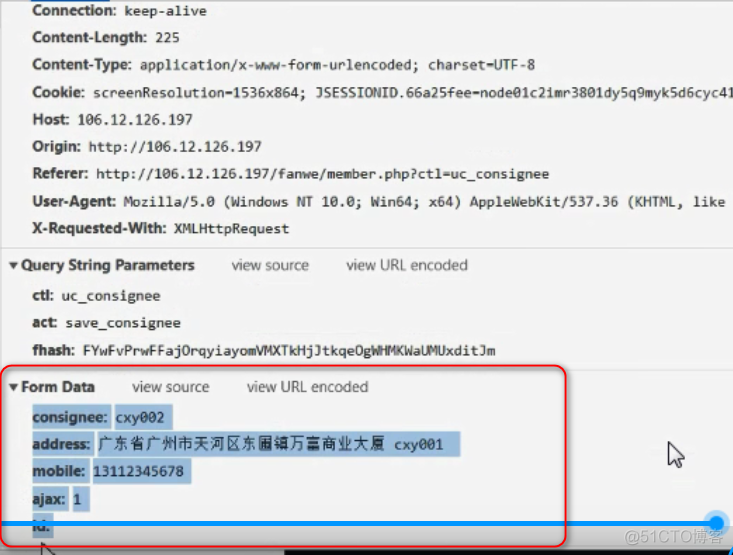
在脚本中发送

查看cookies

- 解码
编码:把码位转换成字节序列(通俗来说:把字符串转换成用于存储或传输的字节序列,python中是.encode())
解码:把字节序列转换成码位(通俗来说:把字节序列转换成人类可读的文本字符串,python中是.decode())
07 requests接口测试-headers值
headers参数不是每个接口都需要添加的,开发可以自行定义。
- 不需要添加headers
def test_51job():
# 前程无忧搜索岗位不需要headers信息
url='https://search.51job.com/list/030200,000000,0000,00,9,99,%25E8%25BD%25AF%25E4%25BB%25B6%25E6%25B5%258B%25E8%25AF%2595%25E5%25B7%25A5%25E7%25A8%258B%25E5%25B8%2588,2,1.html?lang=c&stype=&postchannel=0000&workyear=99&cotype=99°reefrom=99&jobterm=99&companysize=99&providesalary=99&lonlat=0%2C0&radius=-1&ord_field=0&confirmdate=9&fromType=&dibiaoid=0&address=&line=&specialarea=00&from=&welfare='
r_51job=requests.get(url=url)
# print(r_51job.text)
print(r_51job.encoding) # html默认的编码方式是ISO-8859-1
r_51job.encoding='gb2312' # 修改编码方式
print(r_51job.text)
- 乱码问题
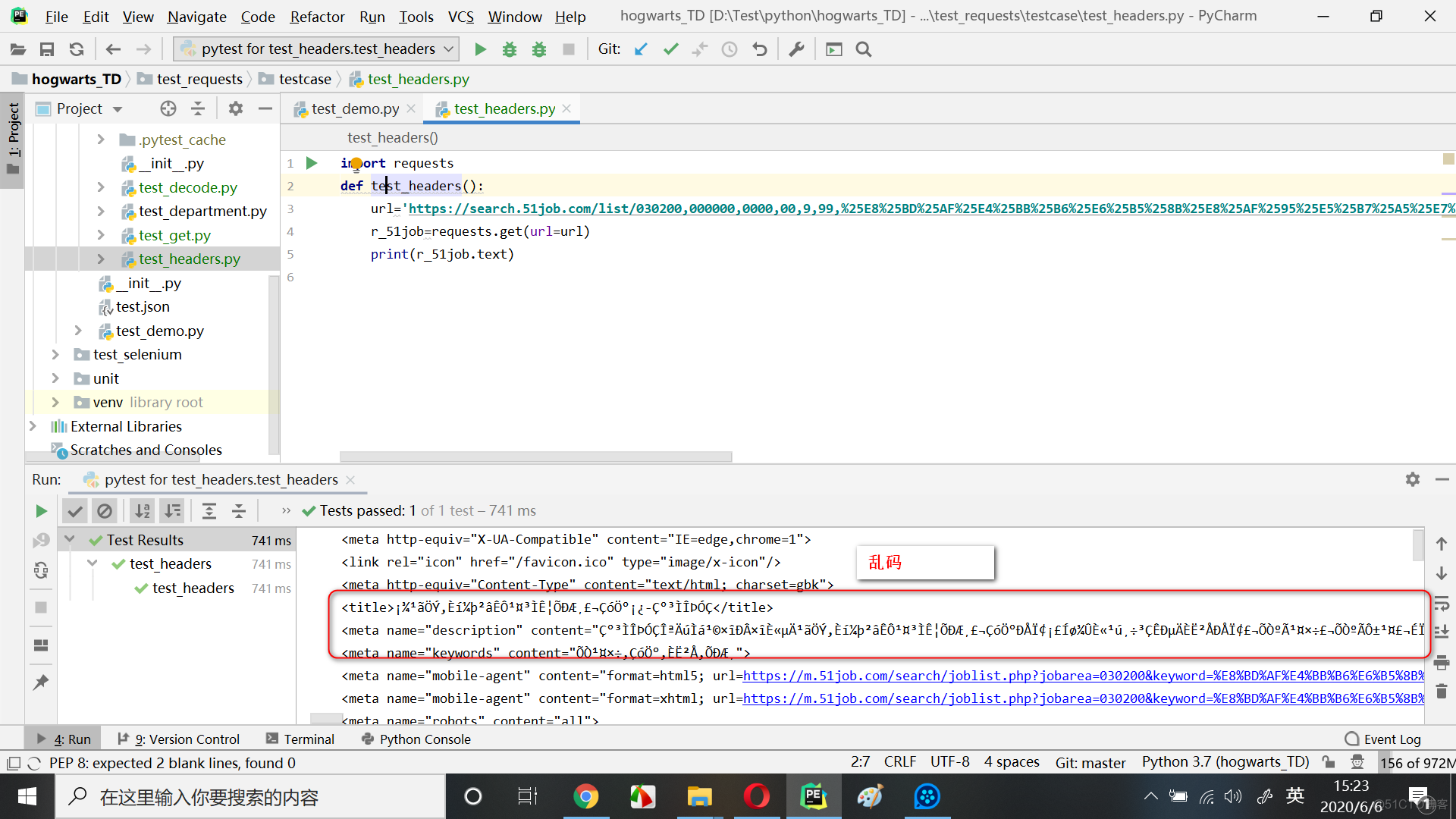

- 需要添加headers
def test_12306():
# 12306搜索车票需要添加headers信息,只需要cookies即可。实际工作中,headers需要哪些值,咨询开发人员了解。
url='https://kyfw.12306.cn/otn/leftTicket/query?leftTicketDTO.train_date=2020-06-06&leftTicketDTO.from_station=SHH&leftTicketDTO.to_station=GZQ&purpose_codes=ADULT'
headers={'Cookie': 'JSESSIONID=C5DCA622147CEF2C4D9C3D3E53E9CF26; BIGipServerotn=1406730506.64545.0000; RAIL_EXPIRATION=1591740743186; RAIL_DEVICEID=FqtrEO_1lQCMdLmY_0uxjBNyLf5esH-V-KtA_I-kPu0j721_HYTxo4IobbdtZbAr75fLtGhLHAQTE8mWEaNmM7ococf3hUVIFw-Gaaper7CzwlrDFsHwwey8w_YQ5gGoMoyfKgVJ5o4nNuWVYhuiC_cxPzsWFJkF; BIGipServerpassport=954728714.50215.0000; route=6f50b51faa11b987e576cdb301e545c4; _jc_save_toStation=%u5E7F%u5DDE%2CGZQ; _jc_save_fromDate=2020-06-06; _jc_save_toDate=2020-06-06; _jc_save_wfdc_flag=dc; _jc_save_fromStation=%u4E0A%u6D77%2CSHH'}
r_12306=requests.get(url=url,headers=headers)
print(r_12306.text)
- 使用chrome查看headers

08 requests接口测试-https证书
https协议需要证书
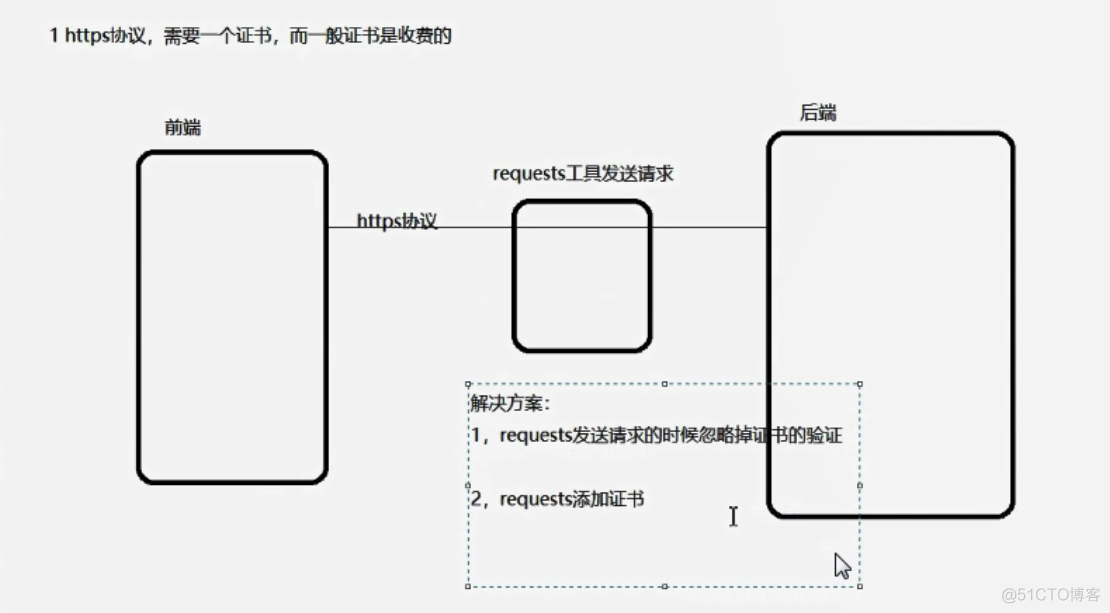
解决方法
- 发送请求时忽略证书,证书参数verify
直接访问,报错。(我自己尝试,没有添加verify尝试,也没有出现错误)
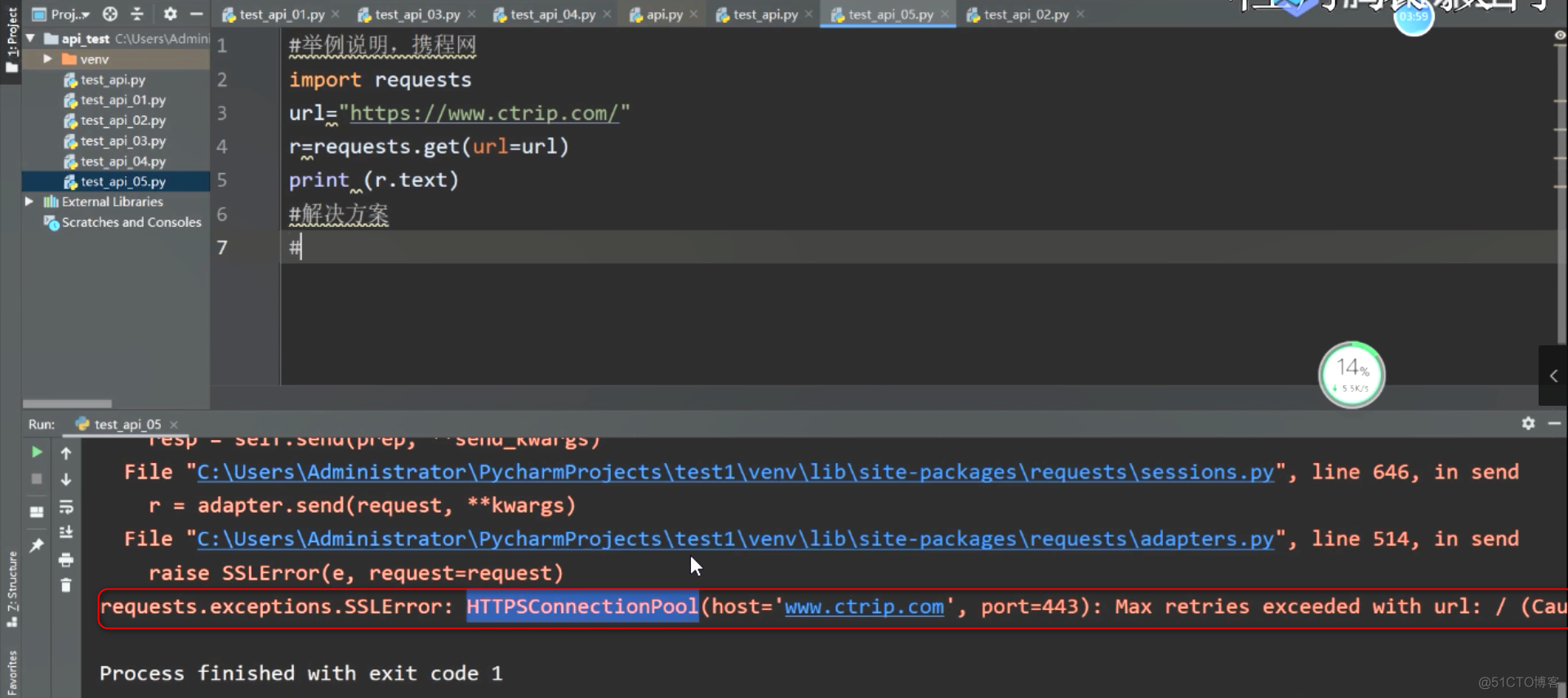
verify参数默认为True,设置为False表示忽略证书

def test_verify():
url='https://www.ctrip.com/'
r=requests.get(url=url,verify=False)
print(r.text)
- 在verify里面添加证书路径
09 requests接口测试-上传文件files参数
- 携程上传头像
def test_files():
url='https://sinfo.ctrip.com/MyInfo/Ajax/UploadPhoto.ashx' # 携程上传头像
cookies={'cookie': 'cookies的值'}
files={'uploadFile_852':('Markdown.jpg',open('D:\\Markdown.jpg','rb'),'image/jpeg')}
r=requests.post(url=url,files=files,verify=False,cookies=cookies)
print(r.text)
files字段说明:
uploadFile_852 文件参数的名字,通过抓包工具查看,实际工作中直接向开发咨询了解。
Markdown.jpg 文件名
open('D:\Markdown.jpg','rb') 打开本地一个文件,注意使用\转义
image/jpeg 文件格式
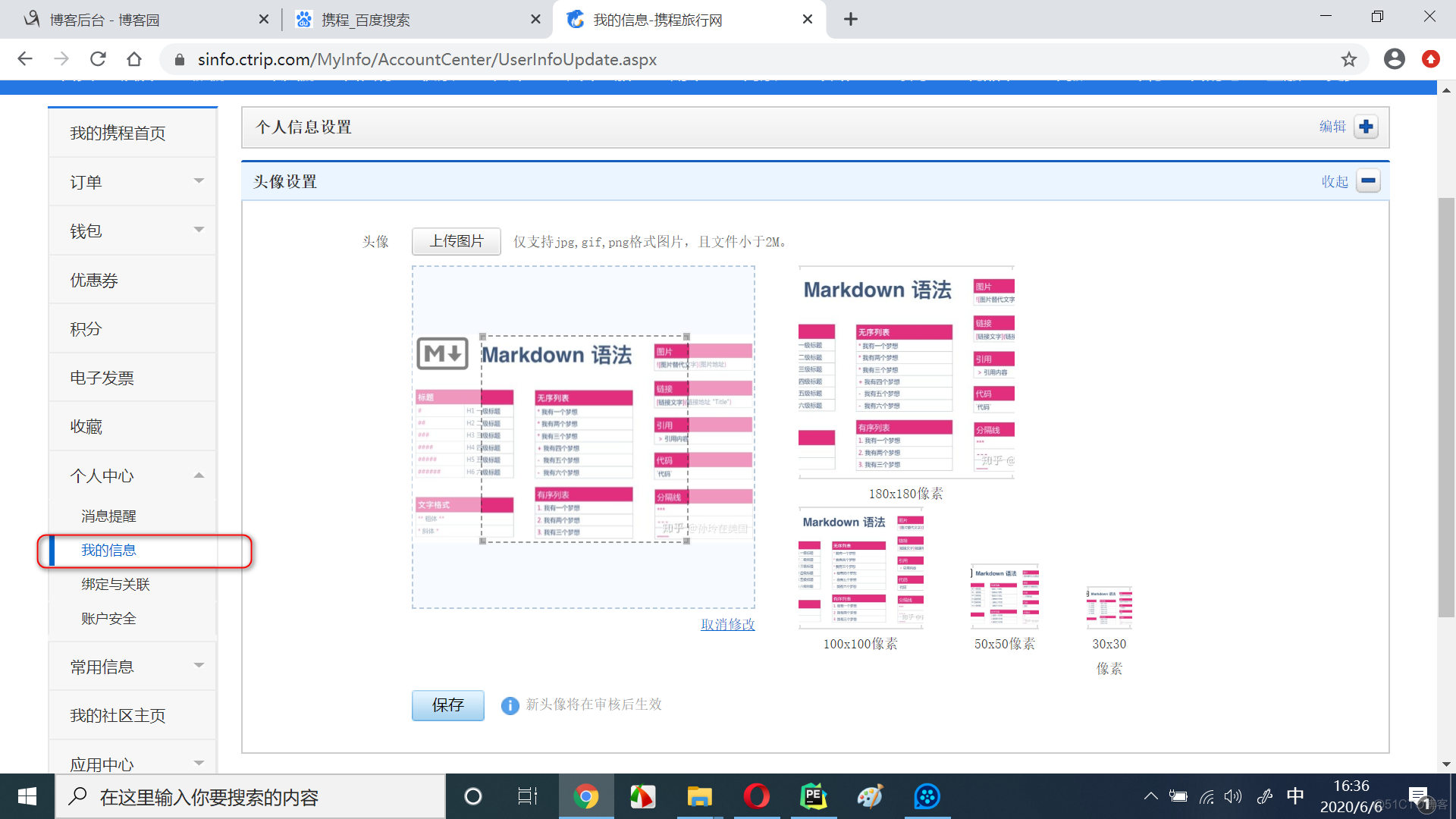
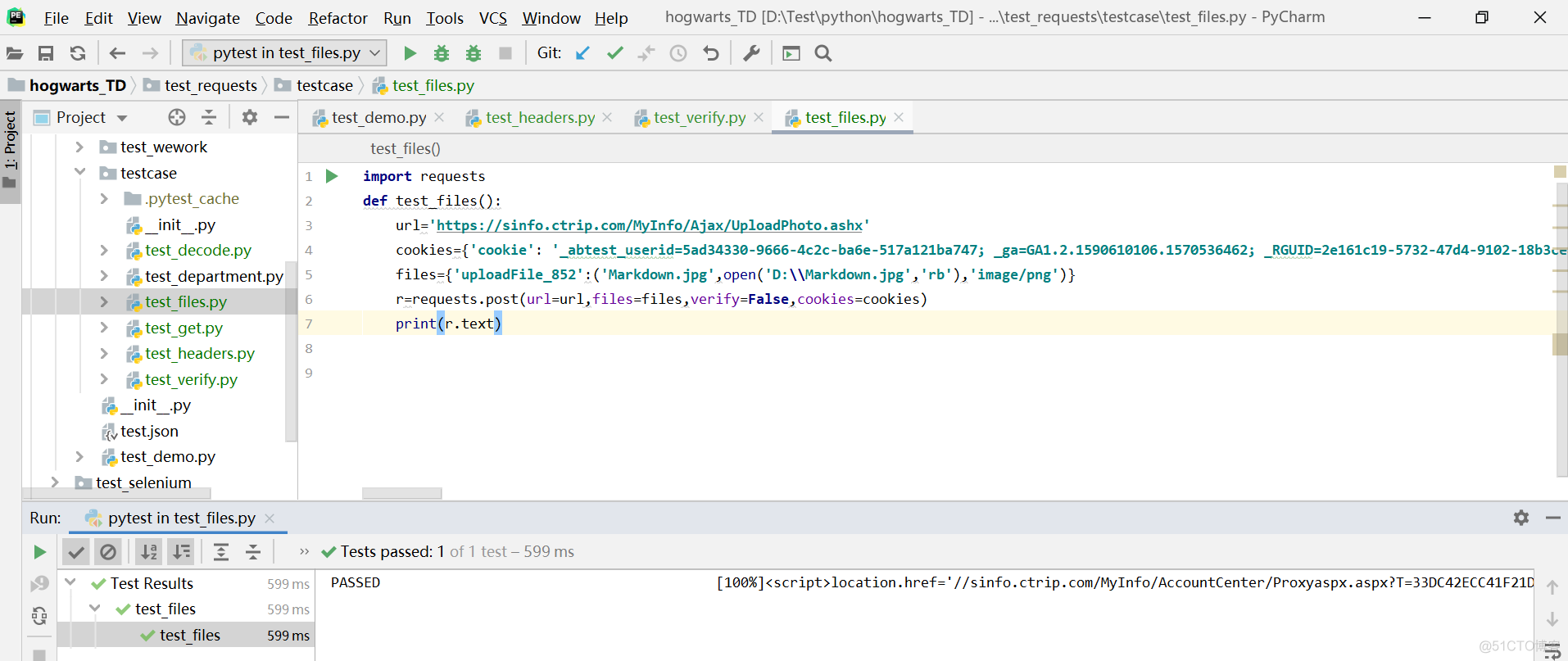
- 禅道上传csv文件
上传文件,你一般需要什么参数?
1.url
2.请求参数
3.请求方式
4.files参数
5.cookies
- 接口测试两个检查点
1.校验返回结果与开发定义的(接口文档)是否一致,如上传成功返回1,上传失败返回0
2.校验接口逻辑是否正确,如上传文件后会把文件保存在服务器的一个目录下,到该目录下检查是否存在上传的文件
10 requests接口测试-timeout超时
- 超时测试介绍

- 超时异常
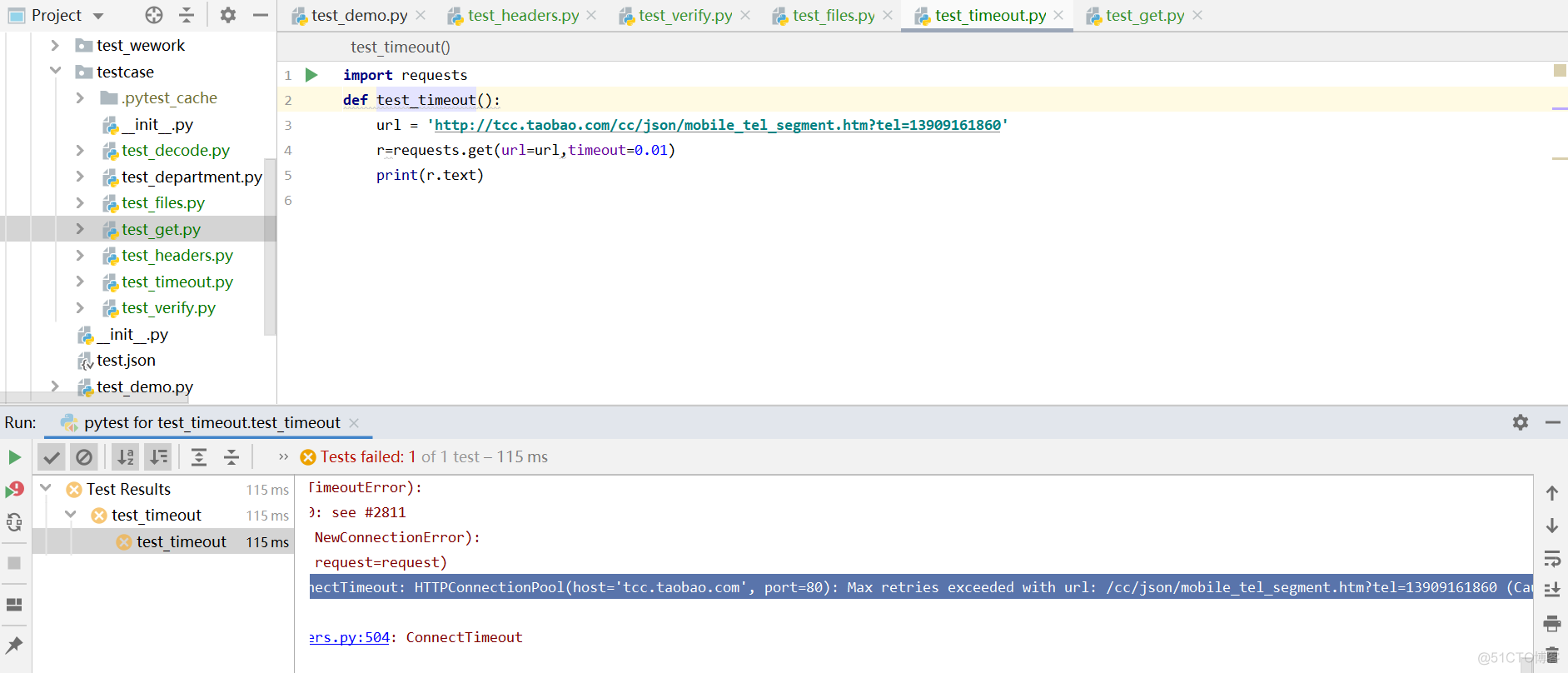
def test_timeout():
url = 'http://tcc.taobao.com/cc/json/mobile_tel_segment.htm?tel=13909161860'
r=requests.get(url=url,timeout=1)
print(r.text)
- 轮循
def test_files():
# 携程上传用户头像
for i in range(0,10):
try:
url='https://sinfo.ctrip.com/MyInfo/Ajax/UploadPhoto.ashx'
cookies={'cookie': 'cookies的值')}
r=requests.post(url=url,files=files,verify=False,cookies=cookies,timeout=0.25)
print(r.text)
except:
print('运行出错')

11 requests接口测试-auth鉴权
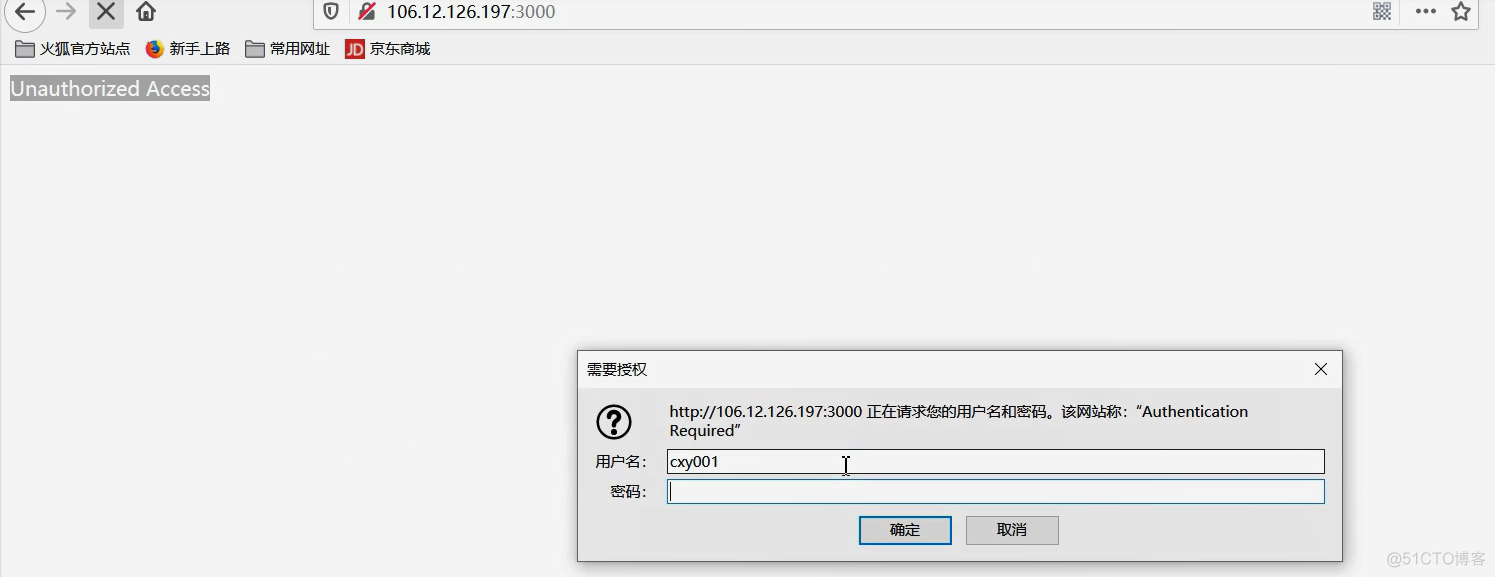
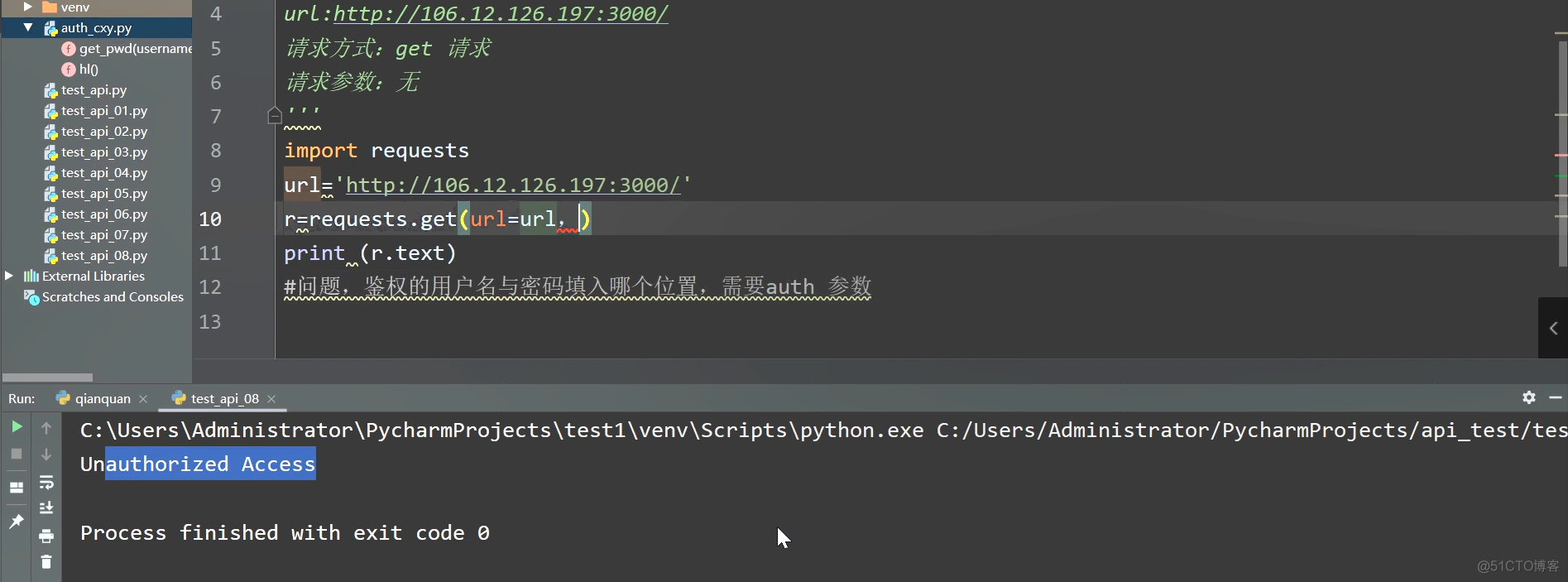

12 requests接口测试-文件下载接口
- 导出禅道用例模板




- 思路

- stream参数的使用
13 requests接口测试-session操作
- 为什么要使用session参数?
有很多接口需要一些公共的参数,比如cookies,可节省时间,精简代码
def test_seesion():s=Session()
s.headers={'h':'test_headers'}
r=s.post('https://httpbin.testing-studio.com/post',data={'a':1}) # 就不需要再单独添加headers
print(r.json())

14 requests接口测试-token的操作

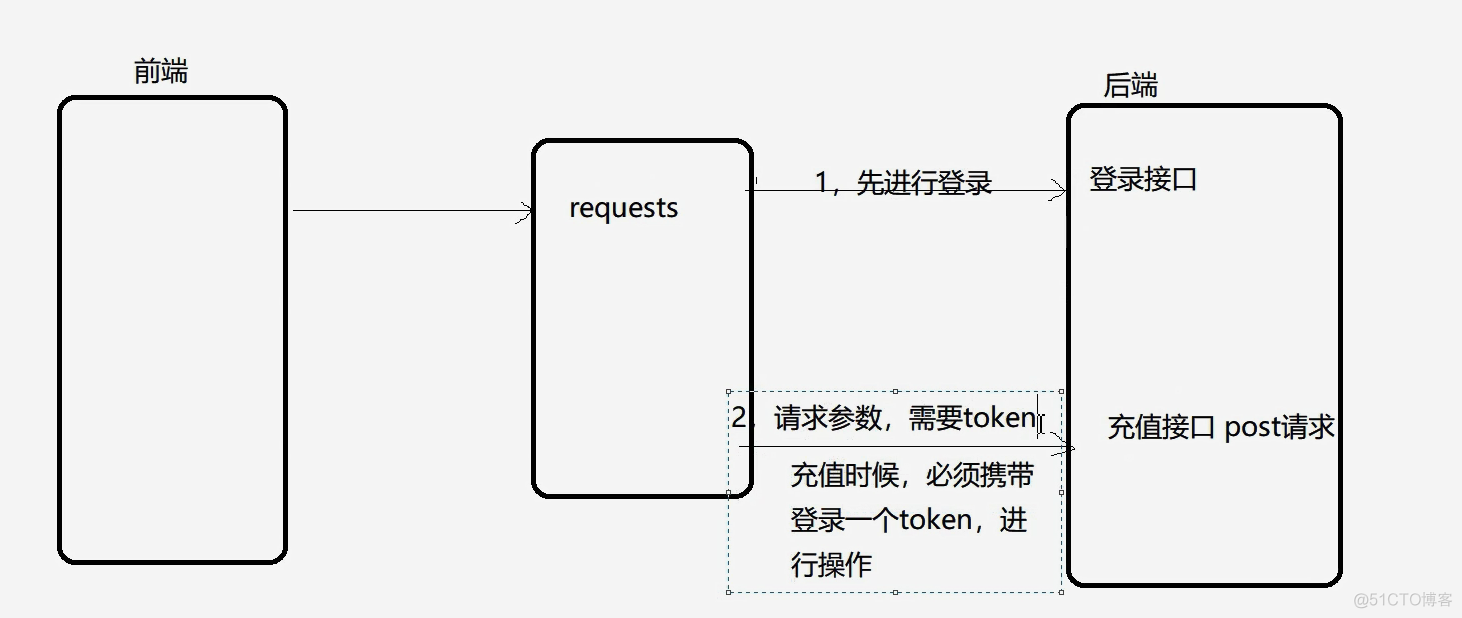
token放在data参数里
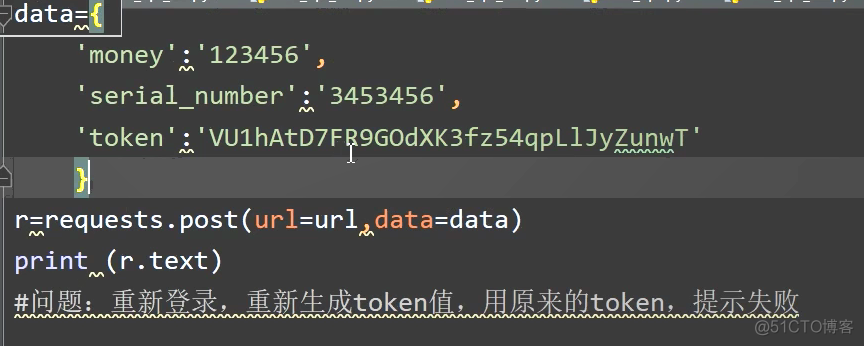
15 requests接口测试-sign签名
- 查看微信支付开发文档:https://pay.weixin.qq.com/wiki/doc/api/index.html
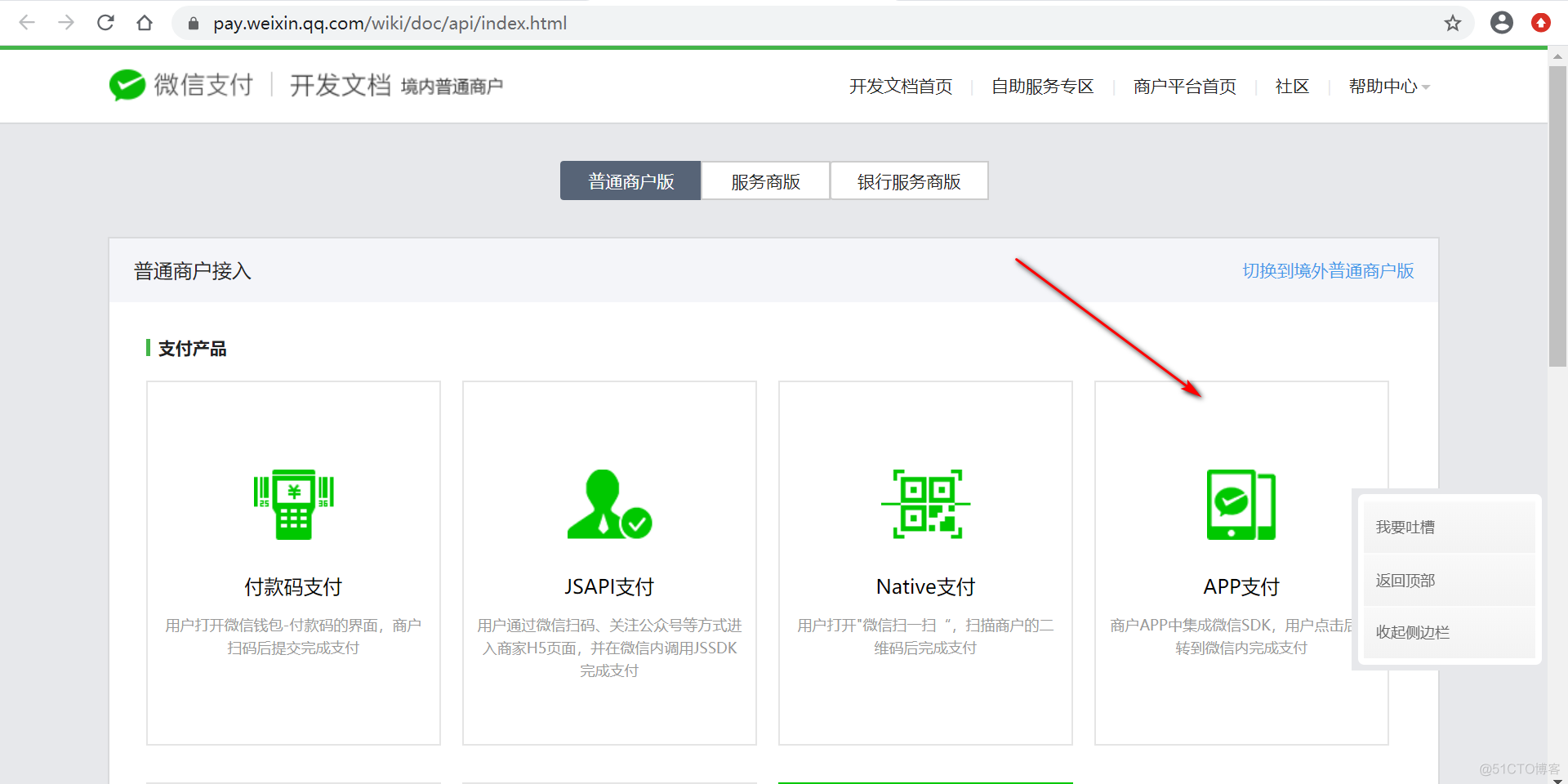
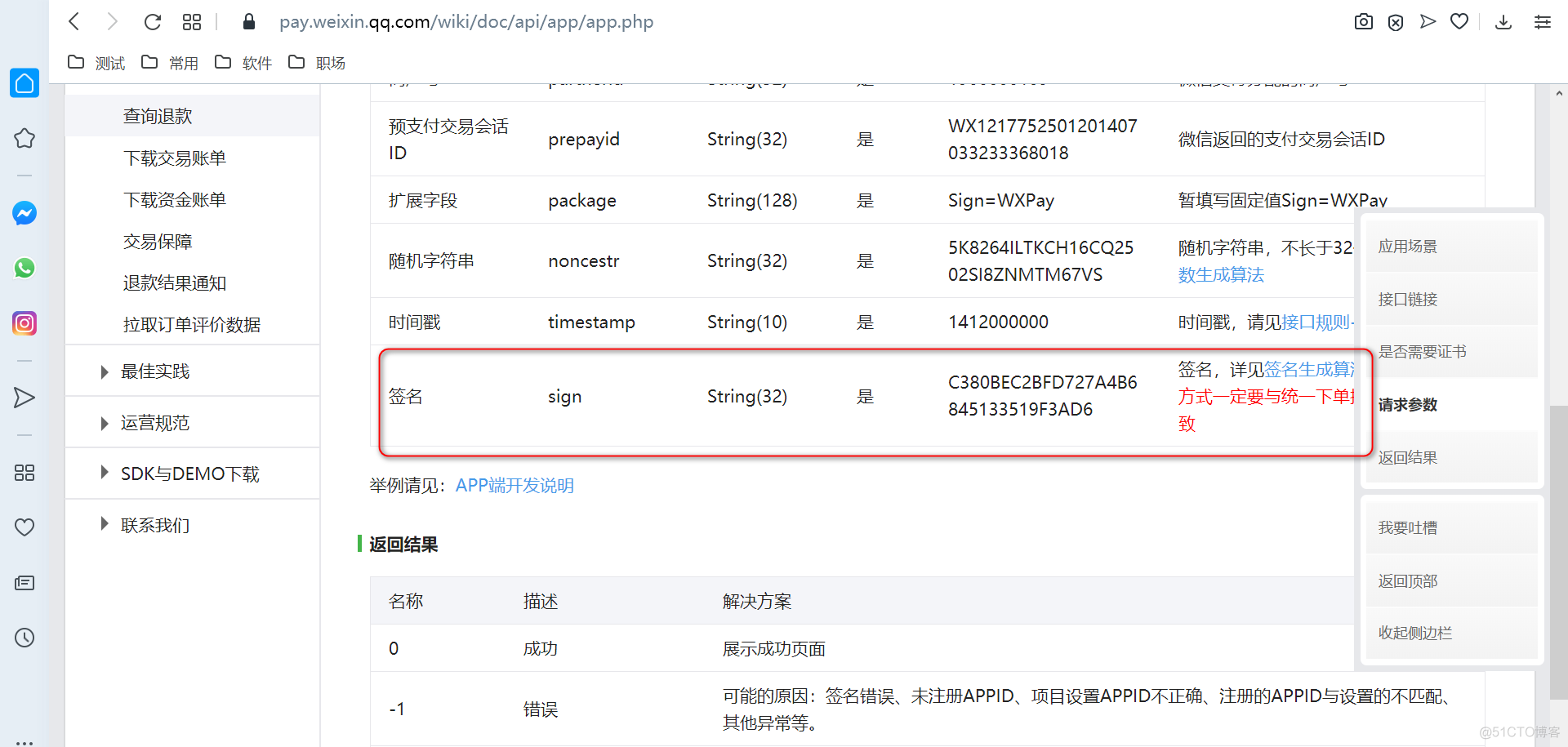
https://pay.weixin.qq.com/wiki/doc/api/app/app.php?chapter=4_3
- 微信支付签名算法
(签名校验工具)
签名生成的通用步骤如下:
第一步,设所有发送或者接收到的数据为集合M,将集合M内非空参数值的参数按照参数名ASCII码从小到大排序(字典序),使用URL键值对的格式(即key1=value1&key2=value2…)拼接成字符串stringA。
特别注意以下重要规则:
◆ 参数名ASCII码从小到大排序(字典序);
◆ 如果参数的值为空不参与签名;
◆ 参数名区分大小写;
◆ 验证调用返回或微信主动通知签名时,传送的sign参数不参与签名,将生成的签名与该sign值作校验。
◆ 微信接口可能增加字段,验证签名时必须支持增加的扩展字段
第二步,在stringA最后拼接上key得到stringSignTemp字符串,并对stringSignTemp进行MD5运算,再将得到的字符串所有字符转换为大写,得到sign值signValue。
◆ key设置路径:微信商户平台(pay.weixin.qq.com)-->账户设置-->API安全-->密钥设置
举例:
假设传送的参数如下:
appid: wxd930ea5d5a258f4fmch_id: 10000100
device_info: 1000
body: test
nonce_str: ibuaiVcKdpRxkhJA
第一步:对参数按照key=value的格式,并按照参数名ASCII字典序排序如下:
stringA="appid=wxd930ea5d5a258f4f&body=test&device_info=1000&mch_id=10000100&nonce_str=ibuaiVcKdpRxkhJA";第二步:拼接API密钥:
stringSignTemp=stringA+"&key=192006250b4c09247ec02edce69f6a2d" //注:key为商户平台设置的密钥keysign=MD5(stringSignTemp).toUpperCase()="9A0A8659F005D6984697E2CA0A9CF3B7" //注:MD5签名方式
sign=hash_hmac("sha256",stringSignTemp,key).toUpperCase()="6A9AE1657590FD6257D693A078E1C3E4BB6BA4DC30B23E0EE2496E54170DACD6" //注:HMAC-SHA256签名方式,部分语言的hmac方法生成结果二进制结果,需要调对应函数转化为十六进制字符串。
最终得到最终发送的数据:
<xml><appid>wxd930ea5d5a258f4f</appid>
<mch_id>10000100</mch_id>
<device_info>1000</device_info>
<body>test</body>
<nonce_str>ibuaiVcKdpRxkhJA</nonce_str>
<sign>9A0A8659F005D6984697E2CA0A9CF3B7</sign>
</xml>
简单来说,就是通过上面的规则生成sign签名,然后放在sign参数发送。
proxies代理机制
proxies = {'http': 'http://127.0.0.1:8888', 'https': 'http://127.0.0.1:8888'}def test_proxies():
r = requests.get("https://httpbin.testing-studio.com/get",
# get请求带query参数 ,为 URL 的查询字符串(query string)传递某种数据
params={
'a': 1,
'b': 2,
'c': 'asd'
},
proxies=proxies,
verify=False # 关闭校验,否则代理无法抓包
)
print(r.json())
hook机制
hook机制可修改响应返回的内容,或替换响应返回的内容。
import requestsdef test_get_hook():
def hook(r,*args,**kwargs):
r.demo = 'demo content'
r = requests.get("https://httpbin.testing-studio.com/get",
params={
'a': 1,
'b': 2,
'c': 'asd'
},
hooks={'response': [hook]}
)
print(r.json())
print(r.demo)
16 requests接口自动化--原则
- 尽量减少后期的维护成本
1.测试数据的维护
2.测试脚本的维护
- 尽量减少测试用例之间的依赖性
- 覆盖的全面性
- 易理解易阅读
规范命名
添加注释
- 最重要的一点是做自动化测试要基于公司的需求,从公司需求出发。
17 requests接口自动化测试-pom模块划分
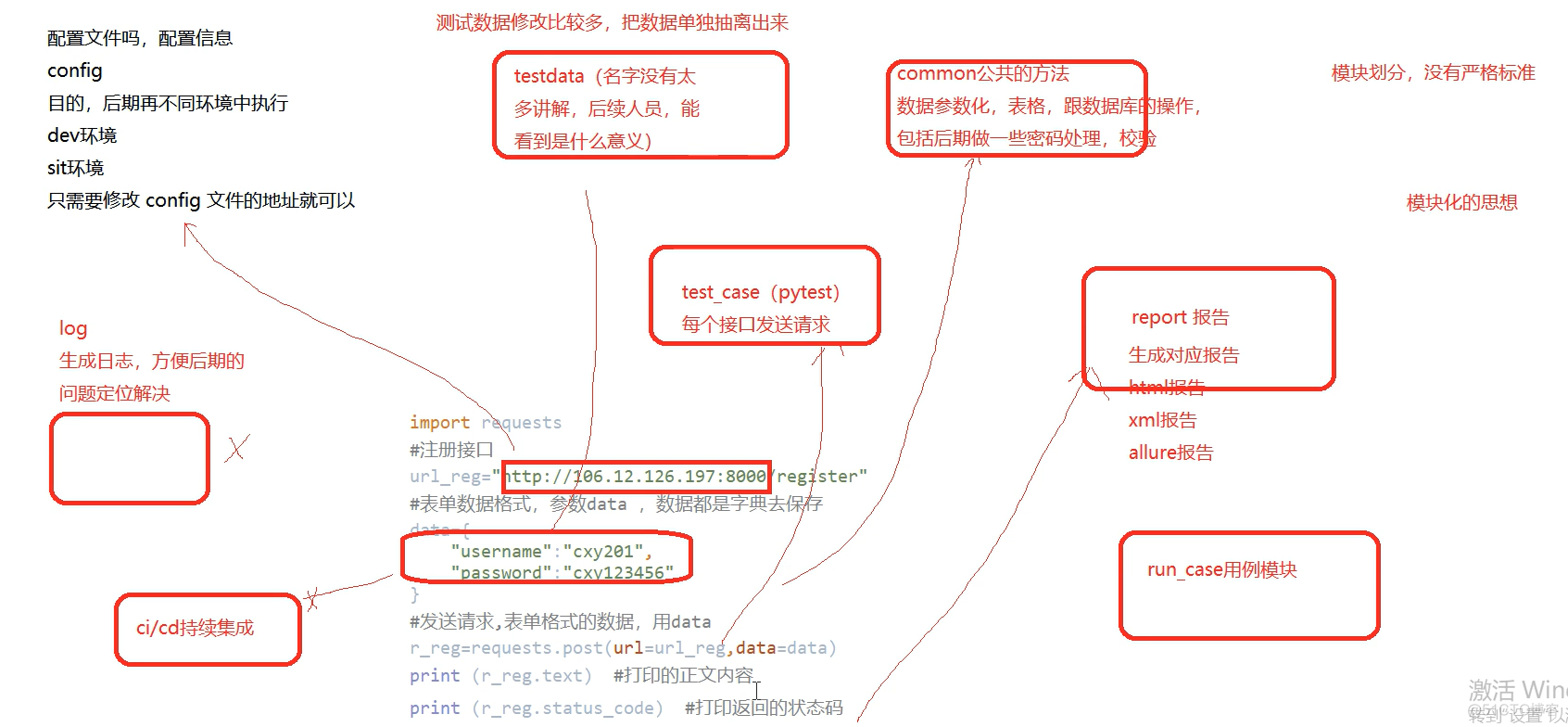
18 requests接口自动化-自定义函数参数化
通过配置文件实现。
在实际工作中,可能需要在不同的测试环境测试,此时可以在配置环境定义好不同的环境,通过更改配置,达到在不同环境进行测试的目的。
配置文件
def server_ip():# 配置文件,通过修改配置,在不同环境进行测试
dev_ip='https://www.baidu.com/'
sit_ip='https://cn.bing.com/'
return sit_ip
def sql_conf():
# 定义数据库的配置
ip=''
username=''
password=''
port=3306
charset='utf-8'
return ip,username,password,port,charsetimport requests
from config.conf import * # 从config导入
def test_conf():
url=server_ip()+'/login' # server_ip()表示引入这个函数,而不是这个方法
print(url)
r=requests.get(url=url)
print(r.text)
import requests
from config.conf import * # 从config导入
def test_conf():
url=server_ip()+'/login' #
print(url)
r=requests.get(url=url)
print(r.text)

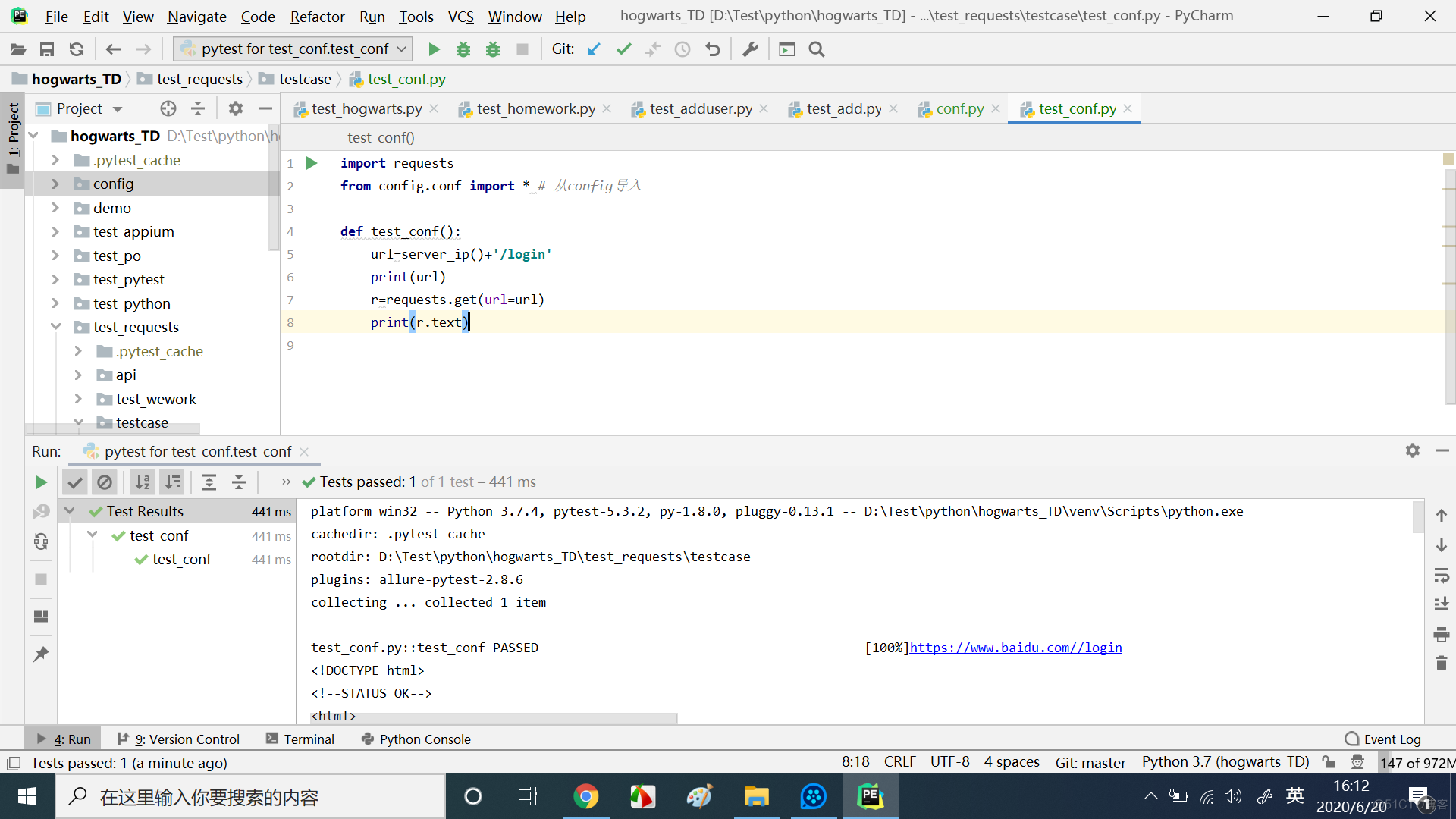

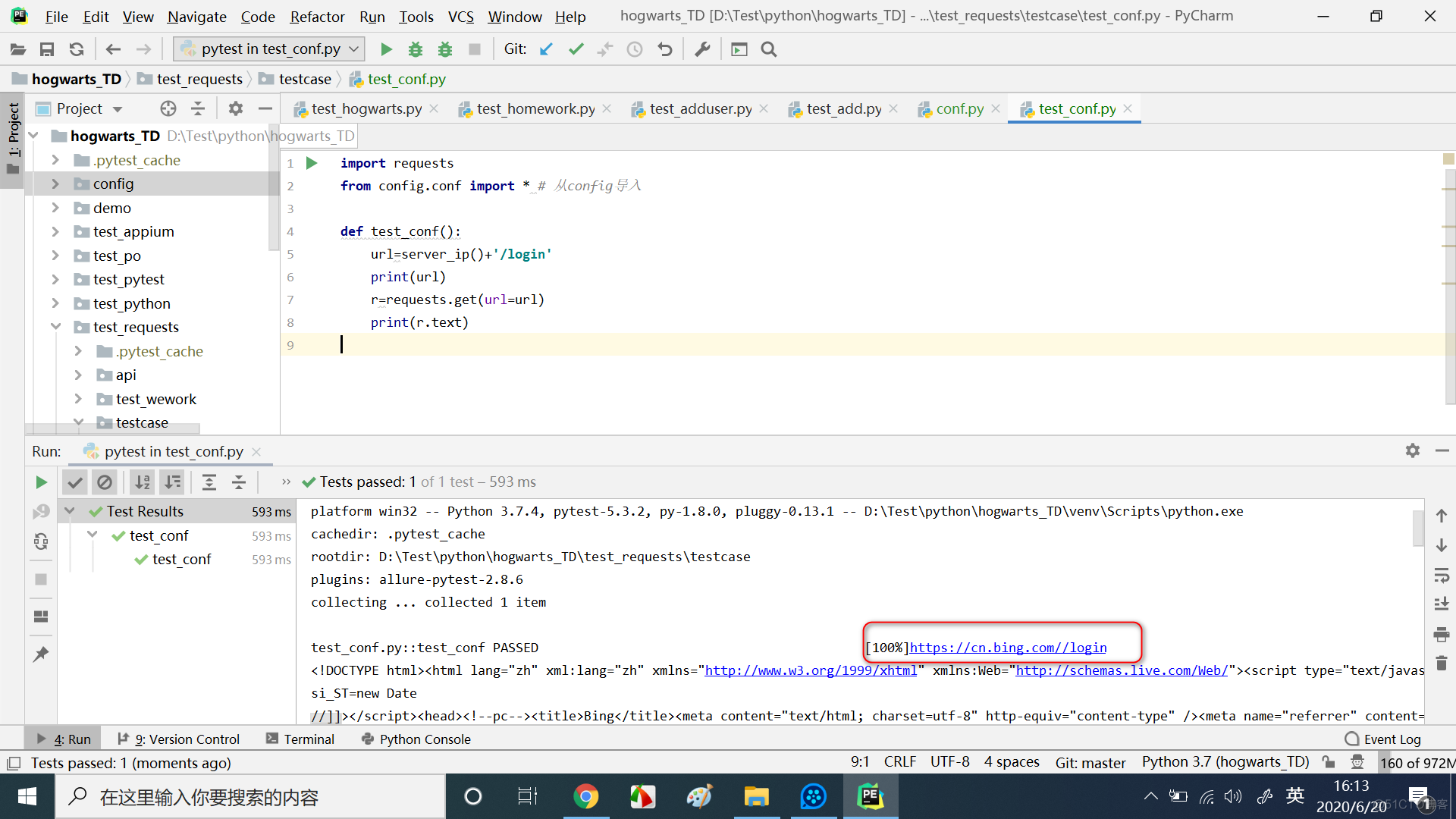
19 requests接口自动化-excel参数化
20 requests接口自动化-数据库参数化
21 requests接口自动化-列表与字典参数化
22 requests接口自动化-动态关联text/html格式
23 requests接口自动化-动态关联json格式
24 requests接口自动化-assert断言
25 pytest框架-安装
26 pytest框架-运行测试用例
27 pytest框架-动态关联
28 pytest框架-生成测试报告
29 Jenkins+requests+pytest+allure持续集成
